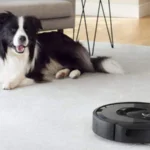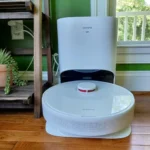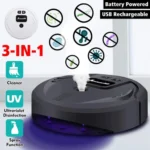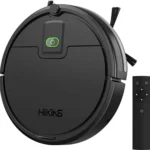Have you ever dreamed of a spotless floor free of pet hair and other allergens, without spending hours on cleaning it? Smart vacuum cleaners are the answer to your prayers, but what about your furry four-legged friend who can’t seem to accept this new technology? The good news is that you can train your pet to get used to a smart vacuum cleaner, and it’s definitely worth the effort. Not only will it make cleaning easier for you, but it will also benefit your pet’s health by reducing allergens in the air. So, let’s dive into the world of pet training and discover why it’s worth teaching your furry companion about this amazing new technology.
Benefits of Training Your Pet
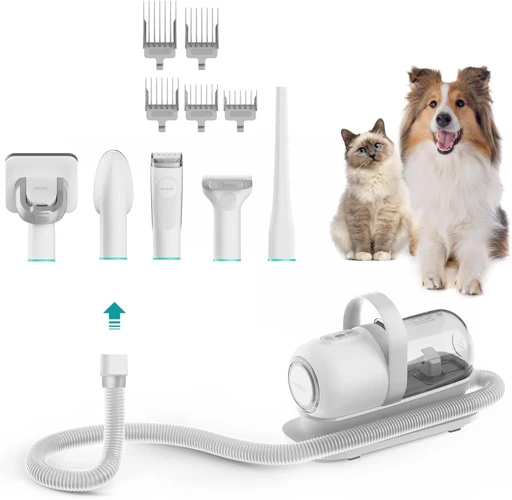
Having a pet is one of the greatest joys in life. Their unconditional love and playful nature bring so much happiness. However, it’s also true that pets can make a mess, especially when it comes to shedding hair. That’s where smart vacuums come in handy. By training your furry friend to get used to the smart vacuum, you can reap a range of benefits. Not only can it save you time and effort, but it can also provide extra help in keeping your home clean and reduce pet hair and allergens. Let’s explore these benefits further. For more tips on pet smart vacuum training, read our related article.
Saves Time and Effort
Training your pet to get used to a smart vacuum cleaner can save you a lot of time and effort compared to manually cleaning up pet hair and debris that accumulates on your floors. By using a smart vacuum, you can simply let it roam your home and pick up all the pet hair and dirt that your furry friend leaves behind.
This means you can spend more time enjoying your pet’s company and less time cleaning up after them. Your smart vacuum can take the burden off your shoulders, freeing up valuable time that you can spend with your furry friend, doing things like going for walks, playing catch, or just cuddling.
Using a smart vacuum can also help keep your home cleaner and tidier. Rather than having pet hair and debris accumulate on your floors, your smart vacuum can keep your floors clean and free of allergens.
With a smart vacuum, you can also say goodbye to the hassle of lugging around a heavy vacuum cleaner, unwinding and rewinding cords, and emptying dustbins. The smart vacuum does all the work for you, leaving you with more time and energy to devote to your furry friend.
So, take the time to train your pet to use a smart vacuum cleaner, and you’ll quickly see the benefits it can provide. For more tips on training your pet to use a smart vacuum, check out our article 5 Tips for Pet Smart Vacuum Training.
Provides Extra Help
Training your pet to get used to a smart vacuum cleaner can provide extra help in keeping your house clean. And not only does it make cleaning more efficient for you, but it also has several benefits for your pets. By allowing them to get used to the smart vacuum cleaner, they will be less stressed and anxious around it, ultimately leading to a better relationship between you and your pet.
Less Stress for Your Pet: Some pets can become scared or anxious around a vacuum cleaner, often because of the noise it produces. However, by training your pet to become comfortable with the smart vacuum cleaner, it can reduce their anxiety and stress levels. This has an added benefit of providing a positive stimulation for them, similar to playing fetch or going for a walk.
Cleaner Air for Your Home: When you train your pet to get used to the smart vacuum cleaner, it can also help reduce the amount of pet hair and allergens in the air. Since a smart vacuum cleaner is constantly cleaning your floors, they can keep your home cleaner and healthier for your pet. This can prevent allergens from building up, leading to better air quality and a safer environment for your furry friend.
Reduced Chance of Accidents: Pets can be unpredictable, and they may accidentally knock over or damage a regular vacuum cleaner. However, training your pet to get used to a smart vacuum cleaner can help reduce the chance of accidents occurring in your home. It can prevent your pet from getting hurt or scared by the vacuum cleaner.
Training your pet to get used to a smart vacuum cleaner provides extra help in a variety of ways. Not only does it make cleaning more convenient, but it will also reduce your pet’s anxiety and stress levels, improve air quality in your home, and decrease the likelihood of any accidents occurring. By following the steps laid out in this article, you can ensure a positive and successful training experience for both you and your furry friend.
For helpful tips on how to calm your scared pet during smart vacuum cleaning, check out our article on the topic. You can also find out more about the mistakes to avoid during the training process in our article on common mistakes pet owners make.
Reduces Pet Hair and Allergens
If you’re a pet owner, you know how difficult it can be to keep your home free of pet hair and allergens. However, training your pet to get used to a smart vacuum cleaner can significantly decrease the amount of pet hair and allergens in the house. Not only does this help reduce allergies, but it can also save you time and effort from having to constantly clean.
When pets shed, their hair can get everywhere, including on furniture, carpets, and even in the air. This is particularly problematic for those who have allergies, as pet hair and dander can exacerbate symptoms. However, if you train your pet to use a smart vacuum cleaner, it can help to keep those pesky allergens and pet hair under control.
Using a smart vacuum cleaner with a specialized pet hair brush is a great way to improve the effectiveness of cleaning. These brushes are designed to pick up pet hair from carpets, furniture, and hard floors. Additionally, smart vacuum cleaners often come equipped with HEPA filters, which can trap tiny particles such as pet dander, dust, and mold. These filters can help to keep the air cleaner and reduce allergens in the home.
By training your pet to get used to a smart vacuum cleaner, you can have extra help in reducing pet hair and allergens in the house. This can save you time and effort from having to constantly clean up after your pet. In turn, this can lead to a happier and healthier living environment for both you and your furry friend.
| Benefits of Reducing Pet Hair and Allergens | Effect of Smart Vacuum Cleaners on Pet Hair and Allergens |
|---|---|
| Reduced allergies | HEPA filters can trap tiny particles such as pet dander to improve air quality |
| Cleaner house | Specialized pet hair brushes can effectively pick up pet hair from carpets, furniture, and hard floors |
| Less time spent cleaning | Smart vacuum cleaners can provide extra help in reducing pet hair and allergens around the house |
Training your pet to use a smart vacuum cleaner can have numerous benefits, including reducing pet hair and allergens around the house. With the right training and equipment, incorporating your pet into your cleaning routine can be a great way to keep your house clean and allergen-free. So why not give it a try and see the difference for yourself? For more tips on keeping your pet calm during vacuum cleaning, check out this article.
How to Train Your Pet to Use a Smart Vacuum Cleaner
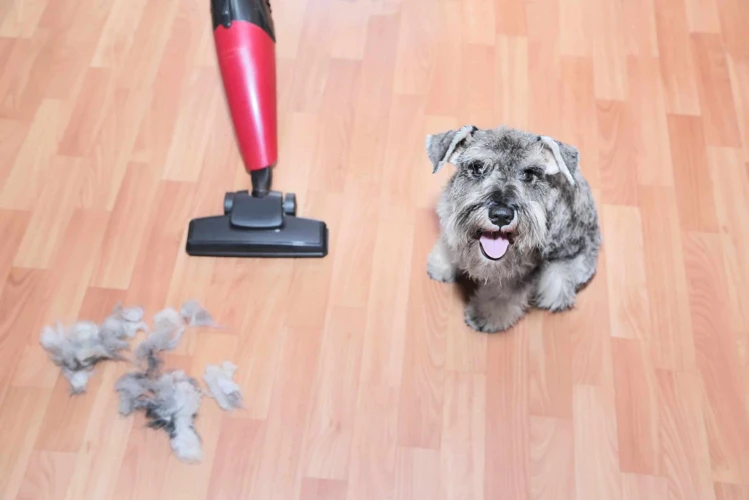
Are you tired of constantly cleaning up pet hair and allergens around your home? Have you considered training your furry friend to use a smart vacuum cleaner? It may seem like a far-fetched idea, but it is actually possible with the right training techniques. In the next section, we will explore the step-by-step process of training your pet to use a smart vacuum cleaner and enjoy the benefits of a cleaner home. So, get ready to discover how to turn your pet into a cleaning assistant!
Step 1: Introduce Your Pet to the Vacuum Cleaner
Introducing your pet to the vacuum cleaner is the first step in the process of training them to use a smart vacuum cleaner. It is important that you approach this step with care and patience to ensure your pet feels at ease around the new object. Here are some steps you can take to make this introduction as smooth as possible:
- Step 1: Start by setting the vacuum cleaner in plain sight but turned off. Allow your pet to sniff and explore the vacuum without feeling any pressure to interact with it.
- Step 2: Once your pet has investigated the vacuum cleaner, turn it on briefly while holding the vacuum cleaner away from your pet. This will allow them to hear and feel the sensation of the vacuum cleaner without feeling threatened.
- Step 3: Gradually move the vacuum cleaner closer to your pet as they become more accustomed to the sound and sensation of it being turned on. Keep the vacuum cleaner at a safe distance, but slowly decrease the distance over time as your pet becomes more comfortable.
- Step 4: Repeat this process several times, making sure each session is brief and positive. Offer treats and praise to reward your pet for their bravery and positive behavior during this process.
It is important to remember that some pets may need more time than others to get used to a new object. Be patient and persistent, and do not force your pet to interact with the vacuum cleaner if they are not ready. A gradual and positive introduction to the vacuum cleaner will go a long way in helping your pet use a smart vacuum cleaner in the future.
Step 2: Practice with Treats
The second step in training your pet to use a smart vacuum cleaner involves using treats to encourage them to get used to the device. Here’s a breakdown of the process:
1) Choose the Right Treats: Start by selecting treats that your pet loves. It’s best to use small bite-sized treats that are easy to give out frequently.
2) Begin the Practice: Introduce your pet to the vacuum cleaner (as discussed in Step 1), and then turn it on. Offer your pet a treat while the vacuum cleaner is in use. Repeat this process gradually,
so that your pet gets used to the sound of the vacuum cleaner while also associating it with rewards.
3) Slowly Increase the Vacuuming Time: Gradually increase the amount of time you run the vacuum cleaner while your pet is present. Remember to keep rewarding them with treats to motivate them to continue.
4) Use Positive Reinforcement: As your pet becomes more comfortable with the vacuum cleaner, encourage them with positive reinforcement. Praise them every time they approach the vacuum cleaner
or interact with it. This can be verbal praise, treats, or a combination of both.
By practicing with treats, your pet will quickly learn to associate the vacuum cleaner with positive experiences. In time, they’ll become comfortable with the device and may even start to follow it around as it cleans. Just remember to take it slow and be patient, and don’t hesitate to reward your furry friend for their progress!
Step 3: Gradually Increase the Vacuum Cleaner Use
Now that your pet has gotten used to the presence and sound of the vacuum cleaner, it’s time to gradually increase its use. This step is crucial to ensure that your pet is comfortable with the vacuum cleaner being used in their presence.
Step 3: Gradually Increase the Vacuum Cleaner Use
- Begin by turning on the vacuum cleaner for a few seconds in the same room as your pet. If they remain calm, give them a treat and praise them.
- Over the next few days, gradually increase the length of time that the vacuum cleaner is turned on. Again, if your pet remains calm, reward them with treats and praise.
- Once your pet is comfortable with the vacuum cleaner being on for a longer period of time, try moving it closer to them. Again, if your pet remains calm, reward them with treats and praise.
- Continue to increase the proximity of the vacuum cleaner to your pet over time, until they are comfortable with it being used in the same room as them.
- Remember to be patient and take things slow. Gradually increasing the use of the vacuum cleaner will ensure that your pet remains comfortable and calm throughout the process.
It’s important to note that not all pets may feel comfortable with the vacuum cleaner being used in their presence. If your pet becomes agitated or fearful during the training process, it may be best to consult with a professional animal behaviorist for additional guidance.
With patience and consistency, however, most pets can be trained to feel comfortable with the use of a smart vacuum cleaner. This will make cleaning your home much easier and less stressful for both you and your furry friend.
Step 4: Reinforce the Behavior with Treats and Praise
Now that your pet has shown a positive response to the smart vacuum cleaner and has successfully followed the previous steps, it’s time to reinforce their behavior with treats and praise. This is a crucial step in training your pet to get used to a smart vacuum cleaner and to ensure its long-term success.
1. Use treats: Make sure to have a good supply of your pet’s favorite treats on hand. Whenever your pet shows positive behavior such as approaching the vacuum cleaner, allowing it to get a little closer, or even touching it, immediately reward your pet with her favorite treat. This positive reinforcement will help your pet associate good behavior with a reward.
2. Use praise: In addition to treats, use verbal praise to encourage good behavior. Whenever your pet approaches the vacuum cleaner, tell her “good girl” or “good boy.” Hearing your positive words will help reinforce the association between good behavior and positive reinforcement.
3. Be consistent: Consistency is key to successful pet training. Make sure to reward your pet with treats and praise every single time she shows positive behavior towards the vacuum cleaner. This will help to reinforce the behavior in your pet’s mind and help her feel more comfortable around the smart vacuum over time.
4. Avoid negative reinforcement: Avoid scolding or physically punishing your pet if she shows a negative reaction to the vacuum cleaner. This can make her fearful or anxious around the vacuum which can hinder her progress in getting used to it. Instead, be patient and use positive reinforcement to encourage better behavior.
By consistently reinforcing positive behaviors with treats and praise, you’ll help your pet feel more confident and at ease around the smart vacuum cleaner. Over time, your pet will become more comfortable and may even view the smart vacuum cleaner as a friendly helper rather than a source of fear or anxiety.
Challenges and Tips
As you begin training your pet to get used to a smart vacuum cleaner, you may face some challenges along the way. These obstacles can range from initial fear and resistance to setbacks during the training process. However, don’t be discouraged! With the right tips and tricks, you can overcome these challenges and successfully train your furry friend to use the smart vacuum cleaner. Let’s dive into some helpful suggestions and ideas to make the training process smoother and more effective.
Challenges
Training your pet to use a smart vacuum cleaner can be a challenge, even for the most obedient pets. Here are some common challenges that you may face:
| Noisy Vacuum: | The loud noise from the vacuum may startle your pet, making it difficult to get them comfortable around the vacuum cleaner. You will need to make sure that they get used to the sound gradually. |
| Moving Parts: | The moving parts and brushes in the vacuum can be unnerving for some pets. Make sure to introduce them to the vacuum cleaner when it’s off so they can inspect it more closely and understand what it is. |
| Suction: | Some pets may find the sensation of suction to be unpleasant or scary. Start with low suction and gradually increase it over time. Always check in with your pet and stop if they seem uncomfortable. |
| Misuse: | Pets that are not properly trained may try to bite, chase, or play with the vacuum cleaner, causing damage to both the vacuum and themselves. Make sure to establish clear boundaries and discourage this behavior with commands or training. |
Overcoming these challenges takes patience and persistence, but the benefits are worth it. With time and effort, your pet will become used to the vacuum and may even learn to enjoy it. Don’t give up, and remember to always reward good behavior with treats and praise.
Tips for Success
When training your pet to get used to a smart vacuum cleaner, there are certain tips that can increase your chances of success. Check out the table below for some helpful tips:
| Tips for Success |
|---|
| Be patient: Rome wasn’t built in a day, and neither is a well-trained pet. Give your pet time to adjust to the vacuum cleaner and don’t rush the process. |
| Use positive reinforcement: When your pet successfully uses the vacuum cleaner, reward them with treats and praise. This will encourage them to continue this behavior. |
| Keep it fun: Training your pet should be a positive experience for both of you. Make it fun with games and activities to keep your pet engaged and motivated. |
| Make it a routine: Like any behavior, training your pet to use a vacuum cleaner requires consistency. Make it a part of your daily routine, so your pet becomes accustomed to it. |
| Start slow: Begin by turning the vacuum cleaner on and off while your pet is in the room so they can get used to the noise. Gradually increase the amount of time the vacuum cleaner is on around your pet. |
| Keep the vacuum cleaner visible: Make sure your pet can see the vacuum cleaner when it’s in use. This will help your pet understand that it’s not a threat and part of their daily routine. |
By following these tips, you can ensure that your pet gets used to the smart vacuum cleaner and even comes to see it as a helpful tool in the household. Remember to stay patient and consistent, and most importantly, have fun while training your pet.
Conclusion
In conclusion, training your pet to get used to a smart vacuum cleaner is definitely worth it. It not only saves you time and effort but also provides extra help in keeping your home clean and reducing the amount of pet hair and allergens in the air.
Remember: It is important to introduce your pet to the vacuum cleaner slowly and with patience. Gradually increase its use and reinforce positive behavior with treats and praise. Don’t forget that challenges may arise, but with the right tips and techniques, you can overcome them and have a successful training experience with your pet.
Overall, training your pet to use a smart vacuum cleaner will not only benefit you in the long run but also create a stronger bond between you and your furry friend. So why not give it a try and see the amazing results for yourself? Your pet and your home will thank you for it.
Frequently Asked Questions
1. Will the noise from the smart vacuum cleaner scare my pet?
It might be scary at first, but with proper training, your pet will learn to get used to the sound and movement of the vacuum cleaner.
2. Can all pets be trained to use a smart vacuum cleaner?
Most pets, including dogs and cats, can be trained to use a smart vacuum cleaner. However, some pets might be too anxious or fearful to adapt.
3. What types of smart vacuum cleaners are suitable for pet owners?
Smart vacuum cleaners with pet-specific features, such as HEPA filters and stronger suction power, are great options for pet owners.
4. Can a smart vacuum cleaner replace regular vacuuming and cleaning?
While a smart vacuum cleaner can help reduce the number of times you need to vacuum and clean, it shouldn’t replace regular cleaning and maintenance.
5. Will using a smart vacuum cleaner affect my pet’s behavior?
Using a smart vacuum cleaner might change your pet’s behavior for the better, as they will learn to associate the vacuum with positive rewards and praise.
6. How long does it take to train a pet to use a smart vacuum cleaner?
The training process can take anywhere from a few days to a few weeks, depending on your pet’s personality and behavior.
7. Can a smart vacuum cleaner cause harm to my pet?
It is unlikely that a smart vacuum cleaner will cause any harm to your pet, as long as you supervise them during the training process and use the vacuum as directed.
8. How often should I use a smart vacuum cleaner with my pet?
You can use a smart vacuum cleaner with your pet as often as needed, but it’s important to remember not to overuse it, as it might cause stress or anxiety for your pet.
9. What if my pet refuses to use the smart vacuum cleaner?
If your pet refuses to use the smart vacuum cleaner, you can try using treats and positive reinforcement to encourage them. If that doesn’t work, it might be best to seek the help of a professional dog trainer or behaviorist.
10. Will training my pet to use a smart vacuum cleaner benefit me in any other way?
Yes, training your pet to use a smart vacuum cleaner can benefit you by reducing the amount of pet hair and allergens in your home, saving you time and effort, and providing extra help with cleaning and maintenance.


